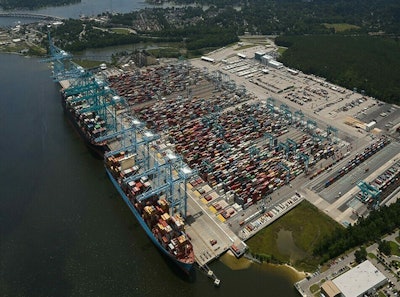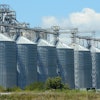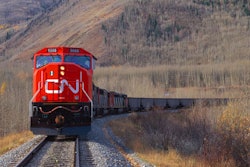
The Port of Virginia is one of the St. Louis region's primary gateways to the world. Dedicated rail service provided by two Class I railroads – Norfolk Southern and CSX – connect the St. Louis region to the east coast port, where more than $900 million has been invested within the past three years.
That investment has doubled the Port of Virginia’s capacity and increased efficiencies for getting freight on and off both rail and ocean carriers. That translates into time and cost savings for importers and exporters in the St. Louis region who utilize the Port of Virginia and its ocean carrier services for global connectivity.
“我们有30周服务与我们的海运承运人customers, and that gives shippers in the St. Louis community or any of our inland connections a lot of options,” says Aaron Katrancha, Director of Breakbulk, Ro-Ro & Rail Sales for the Port of Virginia.
“You can get basically anywhere in the world from the Port of Virginia -- Asia, Africa, Caribbean, Central America, Europe, India, subcontinent, Middle East, Mediterranean, South America, you name it. We have those global connections to offer the St Louis market.”
Of its 30 ocean carrier services, Katrancha says 11 are Asian, something that speaks to the transition in global freight flows in recent years. While it used to be that transpacific trade connected to the West Coast, today, the Port of Virginia’s largest trading partner, for both import and export, is China, with ships coming to the port via the Suez Canal and the widened Panama Canal. This has enabled the Port of Virginia to increase volumes coming through the port, and underscores the importance of its partnerships with the railroads.
Katrancha says when it comes to the rail connections between the intermodal yards in the St. Louis region and the Port of Virginia, the service runs very much like commercial airline service. “Our rail services run on a very concrete schedule that our customers can set their watches to,” he says.
From the St. Louis region, Norfolk Southern currently offers scheduled service six days a week, both on the import and export side. On the import side, once a train is loaded at the port, it reaches the Norfolk Southern Terminal in St. Louis, Missouri, in four days to be picked up by truck and driven to the end destination. Similarly, CSX on the import side offers scheduled service five days a week, with its trains reaching the CSX terminal in East St. Louis, Illinois, in four days as well. On the export side, the CSX scheduled service operates once a week, but Katrancha says that is driven by volume, and once there are new customers, it can increase.
“The advantage for customers in the St Louis region is your combination of nearby intermodal terminals both Class I railroads serve that have a very efficient services connecting to the Port of Virginia, which is also building the capacity and efficiencies of our port terminals and harbor for the future,” says Katrancha. “The flexibility, the reliability, the efficiencies of that global connection is really key. You can't really just manufacture that. You have that. So, I think building off of those efficiencies and knowing those connections exist is key.”
Katrancha talked about the rail connection between the Port of Virginia and the St. Louis region during a virtual conversation on May 26 as part of FreightWeekSTL 2021. Katrancha spoke with Mary Lamie, Executive Vice President of Multi Modal Enterprises at Bi-State Development, which operates the St. Louis Regional Freightway. The Freightway organization is taking the lead in helping to make sure shippers are aware of the scheduled rail services and the benefits they offer.
Given the volumes moving through the Port of Virginia in recent months – even in the midst of COVID-19 -- it is evident shippers have already discovered this gateway and are benefiting from the investments that have been made at the Port of Virginia, including the addition of two new ship to shore cranes, which at 175-feet tall are the biggest in the Americas, capable of handling the largest vessels that come into the port area. Two more cranes will be added this year, providing even greater efficiencies at the east coast port.
“November was an all-time record month for us at the port. And in March, we almost beat that record. That's really saying something because March doesn't usually beat November. November is the peak time for us,” Katrancha says. “We’re proud to say despite the elevated volumes, with the efficiencies and capacity we've put into the terminals, our metrics stayed the same.”
The metrics Katrancha is referring to looked at truck turn times and how quickly a box can be loaded onto a rail car from the water vessel or vice versa, and it stayed within the threshold of 48 hours, which was key to the port during that time. Katrancha says that, not only did they not miss a beat and were able to accept more vessels than they ever had previously, and some of the vessels they did get were because they could not get into another port elsewhere.
“重要的是要注意,不仅仅是一些of these vessels off schedule, they were coming from other places,” says Katrancha. “And we were able to still, within our berth windows, efficiently work the vessels, move boxes between the stacks, work the rail and work the trucks to get them out the door. That is really a testament to not only our operations team and the great work they are doing out there, but also all that work that was put in to create these efficiencies.”
He added they are currently moving about three-point-two million TEU’s a year, which equates to about one-point-seven-million 40-foot containers a year. He also mentioned there is good balance between imports and exports, which is particularly important when looking at the rail side of their business.
“Anywhere between 32% to 38% of our business moves by rail,” Katrancha says. “It is a difficult network to run for the railroads and port terminals if you are moving in a bunch of empty railcars to be able to handle an imbalance between imports and exports. Our relative balance between imports and exports on the rail offers an added efficiency for our rail services. And that's good for the shippers as well. That creates an efficiency there.”
Katrancha says the ocean carriers want to find that most direct service for their containers, which are a big part of their assets. “The ocean carriers want to get those back as quickly as possible. So, it's important to get the containers into a market and then get them back out of the market as efficiently as possible, and we have the most direct rail service to and from St. Louis,” he says. “So, we offer not only the cargo owners, but also the container lines, a very efficient product to and from a port that's got a lot of options, a lot of services for them.”
The shippers desire for viable options is a familiar theme for the St. Louis Regional Freightway, which has spent the past five years highlighting the tremendous freight assets the St. Louis region offers, and building relationships with coastal ports that provide vital connections between the bi-state area and global markets.
“Everything that Aaron has shared today reinforces the global significance of the Port of Virginia and opportunities for growth between our two regions,” Lamie says.
FreightWeekSTL 2021 continues online through May 28 and will feature a variety of additional engaging sessions with industry experts and leaders in freight, logistics and transportation. The week-long event is being delivered by St. Louis Regional Freightway, The Waterways Journal and Bi-State Development. To learn more and register for or view each of remaining sessions or past sessions for FreightWeekSTL 2021, visitfreightweekstl.com.
AboutSt. Louis Regional Freightway
The St. Louis Regional Freightway is a Bi-State Development enterprise formed to create a regional freight district and comprehensive authority for freight operations and opportunities within eight counties in Illinois and Missouri, which comprise the St. Louis metropolitan area. Public sector and private industry businesses are collaborating with the St. Louis Regional Freightway to establish the bi-state region as one of the premier multimodal freight hubs and distribution centers in the United States through marketing, public advocacy, and freight and infrastructure development.





















